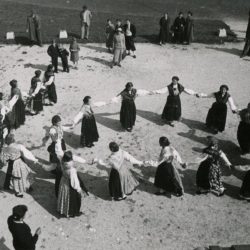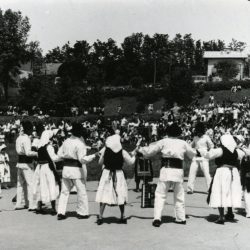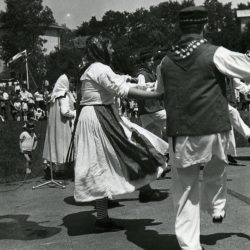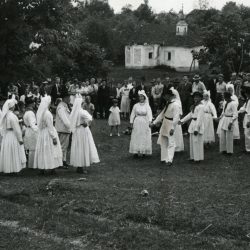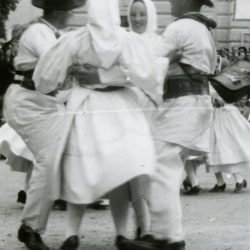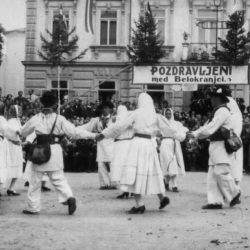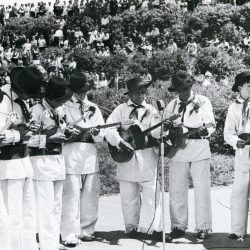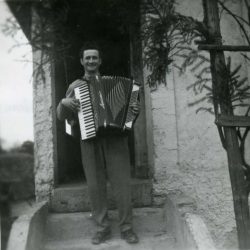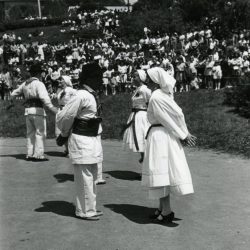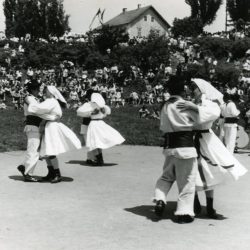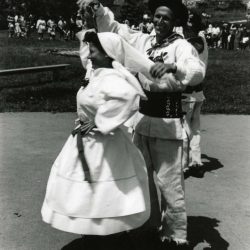Slovenian Folk Dance Music: White Carniola and Kostel
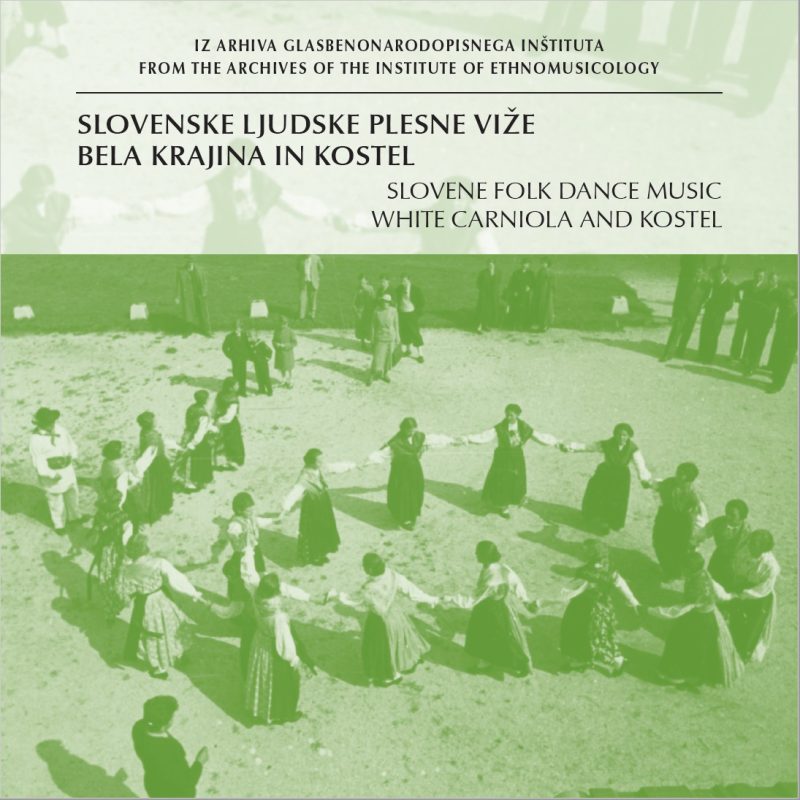
GNI M 27.393
Recorded: Daljne njive, 13. 9. 1965
Sung by: Peter Prebilič (1900)
In the Dinaric parts of the Balkan Peninsula, kolanje denotes dancing in a closed circle while singing various songs, especially ballads. Kolanje always served as an introduction to a fast and lively dance without the accompaniment of singers or instruments. It was introduced to White Carniola by the Uskoks, and therefore it was preserved primarily in Uskok villages and where the Uskok and Slovenian populations mixed. Because song played a major role in kolanje dancing, the movement was simple. Dancers moved around the circle to the left and right while singing; the dance pattern usually consisted of three steps forward and one backwards, but it was also used in versions that differed slightly from the standard form. The oldest report of kolanje dancing in the Poljane Valley was made by Stanko Vraz in his essay “Beli Kranjci” (White Carniolans), published in Danica in 1841 (Vraz, 1877: 53–54). In his description of the dance, which only girls performed, he added that this dance was being abandoned and was now only performed for major festivals. In addition, Vraz reported that the girls sang the song “Zbiraj se, zbiraj lepi zbor.” The singer learned the songs in this recording from his mother, who was born in 1860.
GNI DAT 304
Recorded: Vinica, 8. 1. 2005
Played and sung by: Members of the “Oton Župančič” Folk dance Group from Vinica
Among the songs that used to be sung in Predgrad during kolanje dancing, only the ballad “Pobelelo pole” has been preserved. Today this song is the only known example of a ballad used as a dance song. After the First World War, kolanje dancing was only performed on Saint John’s Day (27 December) and the singing was accompanied by instruments (tambura or accordion) (Ramovš, 1979: 306, 310). After the Second World War, this form of kolanje dancing was adopted by many folk dance groups in White Carniola and elsewhere. They usually do not perform it as kolanje dancing before the faster Silent Dance na trumf (with foot stamping), but independently, which is why the tempo gradually increases, and at the same time the lyrics are shortened to four or five stanzas (Kunej, 2004b: 70–73). This dance is performed in a similar manner, but with full lyrics by the Vinica folk dance group, presented on this audio publication.
GNI M 30.806
Recorded: Črnomelj (Festival of St. George), 1969
Sung by: Members of the Bojanci folk dance group
Kolanje dancing was preserved the longest in Uskok villages. Thus even in the decade after the Second World War, this type of dance was regularly performed in Bojanci and Marindol. Originally, kolanje dancing was performed for major festivals (Easter and Christmas) in front of the church, and at weddings in front of the bridegroom’s house (Ramovš, 1995: 81). In addition to the song recorded on this audio publication, other songs were also sung on this occasion. In Bojanci, kolanje dancing in its original form has been long preserved by the local folk dance group.
GNI M 27.254
Recorded: Črnomelj (Festival of Saint George), 5. 6. 1965
Played and sung by: Members of the Stari Trg ob Kolpi folk dance group
An item published in the newspaper Novice in the mid-nineteenth century demonstrates that kolanje dancing was also performed in Stari Trg ob Kolpi, but that it was being gradually abandoned (Kobe 1837: 415). It was only performed on Saint Stephen’s Day (26 December), and after the First World War it gradually began dying out. After 1945, kolanje dancing was revived by Kristina Majerle for local folk dance group. In addition to the instrumental (tambura) accompaniment, Majerle also added this Croatian song from the island of Krk titled “Verbniče nad moru” to the performance (Ramovš 1995: 83). Majerle also slightly adapted the dance steps in terms of style, which initially made the dance unnatural with a clearly altered execution. Over the years, the folk dance group has gradually (and unconsciously) omitted the “stylistically foreign elements” and moved closer to the version filmed by Božidar Jakac in 1940 (Kunej 2004b: 74–75). The recording on the audio publication offers an impression of a dance performance by locals from Stari Trg ob Kolpi during the Festival of Saint George in Črnomelj.
GNI M 30.807
Recorded: Črnomelj (Festival of Saint George), june 1969
Performed by: Members of the Bojanci folk dance group
Like kolanje dancing, the lively kolo dance that followed it was introduced to White Carniola by the Uskoks. As a dance without singing and instrumental accompaniment, it was only preserved in the Uskok villages (e.g., Bojanci, Marindol, Paunoviči, and Miliči), whereas in the Poljane Valley instruments and even singing were already added to it after the First World War (Ramovš, 1995: 85). In the Uskok villages, this lively dance was called the mutasto kolo (Silent Kolo) because of the lack of singing and instrumental accompaniment, and because the sound image of the dance consists merely of the stamping of the dancers’ feet.
GNI M 27.255
Recorded: Črnomelj (Festival of Saint George), 5. 6. 1965
Sung and played by: Members of the Stari Trg ob Kolpi folk dance group
A version of the lively kolo dance performed after kolanje dancing was also preserved in Stari Trg ob Kolpi, where it was initially also without singing and instrumental accompaniment. However, in the years following the First World War, it was gradually abandoned together with kolanje dancing. Later, the dance was revitalized by the local folk dance group and given a completely different character: it was accompanied by tambura players and the song after which the dance was also named (Ramovš, 1995: 88–91, Kunej 2004b: 79–80). This audio recording was made during a dance performance by people from Stari Trg ob Kolpi during the Festival of Saint George in Črnomelj.
GNI M 24. 509
Recorded: Predgrad, 26. 6. 1961
Sung by: Meta Štaudohar (1914), Marjeta Smuk (1908), Katica Bižal (1933), Katica Štefanc (1926)
“Bridge” games (mostne igre) are characterized by the dancers passing underneath a “bridge” of raised clasped hands of one or more couples. It is assumed that the figure of the bridge once had a magical and ritual meaning of a symbolic act of rebirth (Orel, 1936). The first group of this type is comprised of the games Al je kaj trden ta vaš most (Is This Bridge of Yours Strong). Although these are similar to a children’s game of Indo-European origin, the special feature of the White Carniolan versions is that they were danced by adults. In terms of form, the White Carniolan versions differ significantly from the children’s versions because the dancers are divided into two groups (they stand in two semicircles or rows, facing one another) and reply to one another by singing. In the end, all of the dancers run through a gate – that is, underneath the raised arms of two dancers or the entire opposite row. In Predgrad, this game was performed on Easter Monday before the kolo dance; originally, the game was performed in front of the Auersperg Castle, where, according to oral tradition, nobility and peasants were said to face one another. This was supposed to be the only time in the year that the peasants were allowed to openly state their opinion about the nobility (Ramovš, 1995: 67). Later on, the “bridge” game was performed in the center of the village – that is, on the square in front of the local inn.
GNI M 27.549
Recorded: Črnomelj (Festival of Saint George), 5. 6. 1965
Sung by: Members of the Predgrad folk dance group
In Predgrad, the first part of the game Jel je trden ta vaš most, during which the dancers were divided into two rows, concluded in a closed semicircle. The dance then continued with the dancers passing underneath the “bridge.” This part of the game is also called vrečo šivat (Sewing the Sack) and could also be danced independently at weddings and on other occasions. When it was performed as part of the “bridge,” it was accompanied by the song “Naša mlada nevesta” (Our Young Bride); generally, it could also be performed without a song or suitable instrumental accompaniment (Ramovš, 1995: 72). This recording was made in the 1960s at the Festival of Saint George in Črnomelj. In addition to the performance, the recording also contains comments by the ethnochoreologist Mirko Ramovš. He used the comments to facilitate his transcription because at that time the institute did not yet have a film camera.
GNI M 27.541
Recorded: Črnomelj (Festival of Saint George), 5. 6. 1966
Sung by: Members of the Metlika folk dance group
In addition to the “bridge” game illustrated by this recording, the Metlika tradition also includes the metliško kolo (Metlika Kolo) and the games rešetca (Sieves), robčeci (Handkerchiefs), the kurji boj (Chicken Fight), and the turn (Tower). According to the information collected to date, all of these were first described as early as 1888 (Navratil, 1888: 294–98, 337–45, 412–17) under the common name metliško kolo. This combination of a kolo dance and dance games was first referred to as a “ritual” or “ceremony” by France Marolt in his 1936 study Tri obredja iz Bele krajine (Three Rituals from White Carniola); it is well known that Marolt inserted some changes into the performance (Kunej, 2004b: 61). As part of their tradition, the people of Metlika performed Al je trden ta vaš must every year up until the Second World War; they performed it on Easter Monday in the pungert – a meadow next to St. Martin’s Church outside Metlika (Ramovš, 1995: 31). During this “bridge” game, the couples first divided into two rows that faced one another and then in alternation replied to one another in song (as dictated by the lyrics); at the same time, they held hands and swung them forwards and backwards. At the end of the sung lyrics, one of the rows raised its clasped hands high, forming a bridge arch, and the opposite row ran underneath it, with the “black-eyed girl” taking the lead. In the end, the couples that “held the bridge” also ran under this arch. After 1991, the Metlika folk dance group revived the performance of this ritual on Easter Monday.
GNI wax cylinder no. 3
Recorded: Adlešiči, 31. 5. 1914
Sung by: Ferdo Požeg (1893), Miha Požeg (1892), Jurij Požeg (1889), Miha Adlešič (1841), Mare Adlešič (1894), Kate Adlešič (1895), Ane Rožman (1893), Mare Požeg (1896)
The earliest recordings of Slovenian folk music include two recordings of part of the “bridge” game Al je kaj trden ta vaš most. The first was recorded in 1913 by the Russian researcher Eugenia Lineva and is now kept at the archive in St. Petersburg. The second one, presenting the performance of four women and four men, was recorded a year later by Juro Adlešič and is now kept at the GNI archive. Because the cylinder was later damaged, the recorded content was only able to be heard in 2005, when it was restored (Kunej, 2008: 158–9). By including the recording on this audio publication, one of the oldest audio examples of Slovenian dance heritage is presented to the general public for the first time. Because of the nature of the original sound medium and the damage to it, this recording is short and of poor quality.
GNI M 36.922
Recorded: Bojanci, 10. 12. 1976
Played by: Niko Vrlinič (1921)
It is impossible to establish when and from where this kolo dance of Serbian origin was introduced to White Carniola. It was most likely introduced at the end of the nineteenth century or just before the First World War. From the musical and choreological point of view, the White Carniolan versions resemble the original, with the only difference that the sudden change of dance direction, which is the basic characteristic of this dance, does not happen until the second part (Ramovš, 1995: 92). The people of Bojanci believe that Hruške, jabuke, slive is their dance, and that the people of Adlešiči borrowed it from them and unfairly claim it as their own (TZ MR 1: 64–65). A fact in favor of Adlešiči is that they always name their dance after the first verse of the dance song, and that it is referred to as the adlešičko kolo (Adlešiči Kolo) only by others (France Marolt most likely being the first). In any case, the kolo dance Hruške, jabuke, slive spread from Adlešiči to other places along the Kolpa River; to some it spread soon and to others later, when folk dance groups began borrowing dances and adapting them in their own way. Although only the instrumental performance can be heard on this recording, this dance was usually accompanied by a song with suitable lyrics.
GNI M 27.246
Recorded: Črnomelj (Festival of Saint George), 5. 6. 1965
Played by: Tambura players of the Bojanci folk dance group
The Seljančica (Little Farmer Girl) is a Serbian kolo dance, which was introduced to Slovenia at the end of the nineteenth century together with tambura playing, and became more strongly established during the interwar period. Some information indicates that it was already performed at events organized by reading societies to express connectedness with other South Slavic nations. Close to the Croatian border, the dance was also performed at weddings. However, its melody, to which the kačo vit (Wind the Snake – a twisting line dance) was performed, spread more than the dance itself (Ramovš, 1995: 111). It is not known when this dance first appeared in White Carniola, but it had to have appeared first among the Serbian population. It is believed to have been introduced to the repertoire of some White Carniolan groups from Bojanci. Various paraphrases of the dance melody also developed. These paraphrases mainly involved trivial content for people to remember the dance melody more easily; however, often the dance was named after these paraphrases. Many of today’s folk dance groups sing these paraphrases while dancing in order to embellish their performance.
GNI M 27.405
Recorded: Dragatuš, 13. 9. 1965
Played by: Two musicians of the Dragatuš folk dance group
Lepa Anka (Beautiful Anka) is one of the best-known White Carniolan kolo dances. It was introduced to White Carniola from Croatia, but it is not clear when and from which part of Croatia. The dance was first performed in Adlešiči and Preloka (Ramovš, 1995: 101), from which it spread to other villages in White Carniola, mostly through folk dance groups. Today this dance is only preserved in the performances of many folk dance groups, and not only those from White Carniola; its recognizability is greatly influenced by the fact that is part of the primary-school curriculum and thus many children become familiar with it. The dance versions of Lepa Anka are all similar to one another: in the second part, the circle is divided into couples. The dance was first noted down in 1952 (GNI Pl 116); however, Božidar Jakac filmed it even prior to this – in 1940, during the filming of the Folk Dance Festival and Midsummer Eve Celebration in Metlika. Although this is a silent film, it represents an important choreological source documenting a dance form that was later abandoned (Kunej, 2004b: 46–47, 85). This recording does not present the standard musical accompaniment to this dance (the tambura or accordion players), but seeks to demonstrate how one can play in an original manner even with such a simple instrument as the friction drum.
GNI DAT 304
Recorded: Vinica, 8. 1. 2005
Sung and played by: Members of the Oton Župančič Folk Dance Group from Vinica
This little two-couple kolo dance was introduced to White Carniola from the Croatian side of the Kolpa River (Ramovš, 1995: 117), which is also shown by its original names, such as the hrvacki ‘Croatian’ (in Vinica), the hrvatsko kolo ‘Croatian Kolo’ (in Preloka), and the kolo hrvacka ‘Croatian Kolo’ (in Bojanci). Because it was predominantly performed at weddings, the people of Preloka gave it the name the svatsko kolo (Wedding Kolo), whereas the more recent name the zvezda ‘Star’ (in Vinica and Preloka) began to be used because of the characteristic star shape that is created during spinning. The spinning starts slow and then it becomes increasingly faster; if the girls cannot stay on the ground, the force of spinning lifts them into the air. This lifting has become almost obligatory in folk dance performances because of its appeal and only a few folk dance groups leave it out. The Vinica folk dance group also performs this way, adding to the effect on stage by changing the dance direction (Kunej, 2004b: 97).
GNI M 27.955/a
Recorded: Preloka, February 1957
Played by: Jože Starešinič (1933)
The existence of the dance called the zvezda (Star), in which dancers spin around a circle, alternating left and right, is proven by the earliest silent recordings of Slovenian folk dance filmed in 1940. The people of Preloka performed it in this manner at the Folk Dance Festival and Midsummer Eve Celebration in Metlika (Kunej, 2004b: 95). The audio recording on this audio publication is from a later date and seeks to demonstrate the musical image of this dance.
GNI DAT 305
Recorded: Vinica, 8. 1. 2005
Played and sung by: Members of the Otom Župančič Folk Dance Group from Vinica
The dance game in which a dancer chooses a partner using a pillow was widespread in both White Carniola and Kostel. It was usually named Igraj kolo after the accompanying song of Croatian origin. The special feature of this version from Vinica is its stricter form because its steps resembled those used in the old Vinica kolo dance; by performing the game of choosing a partner to the Croatian melody, the dance presumably used the kolanje dancing steps, which means that kolanje dancing was still alive when this game first appeared. Kolanje dancing was abandoned, but the game of choosing a partner lived on (Ramovš, 1955: 125).
GNI M 30.795
Recorded: Črnomelj (Festival of Saint George), June 1969
Performed by: Members of the Semič folk dance group
The dance song Igraj kolo began to be used in White Carniola primarily with the introduction of tambura players; however, according to Ivan Navratil, it had already been used in the second half of the nineteenth century (Navratil, 1888: 496–97). Dancing to the borrowed melody was nothing new because White Carniolans had already known the same game called the povštertanc or puštrtanc (Pillow Dance). The only difference was that the Pillow Dance did not have a standard melody or a standard form, which is required by the melody Igraj kolo. Therefore it is no coincidence that both names were simultaneously used for the game with the new melody (i.e., Igraj kolo).
GNI M 24.430
Recorded: Črnomelj, 23. 6. 1961
Narrated and sung by: Katarina Kramarič (1903)
In White Carniola and Kostel, the dance resembling kačo zvijat (Wind the Snake) was also performed at weddings. Its name differed by individual village. This recording features a passage from the informant’s narration on how the dance Abraham ma sedem sinov was performed in Črnomelj.
GNI M 20.033
Recorded: Preloka, 27. 1. 1955
Played by: Tambura players from Preloka
The dance game in which dancers change partners and the unpaired dancer dances with a broom was widely known across all of White Carniola and in Kostel. It was performed to any kind of polka and also to the one presented in this audio publication, which the institute’s associates recorded in Preloka in 1955. This audio example is one of the first tape recordings (Kunej, 1999: 220) made as part of the institute’s systematic field research.
GNI M 24.053
Recorded: Vas, 17. 10. 1960
Played by: Lojze Jakšič (1908) from Jakšiči
In addition to the game in which a dancer holds a pillow to chose a partner, games were also used in White Carniola and Kostel in which a dancer chose a partner by sitting on a chair and holding a mirror (villages under the Gorjanci Hills and Mount Mirna) or in which dancers sat on a chair and turned away from the undesired partner, asking for a dance, together with the chair (Vinica, Preloka, and Kostel) (Ramovš, 1995: 140–41). For these kinds of games, the musician played different melodies during the selection of partners; however, for a couples dance, he only played the waltz or a polka, like the one presented in this audio publication.
GNI M 24.495
Recorded: Stari trg ob Kolpi, 26. 6. 1961
Sung by: Kristina Majerle (1915), Štefka Butala (1932)
A special feature in the activities of folk dance groups in White Carniola after the Second World War is the revived and newly developed kolo dances. They were created because folk dance groups did not have enough dances typical only of their area in their programs. They therefore used older people’s memories to revive or reconstruct the forgotten kolo dances, borrowed dances from other groups and transformed them in terms of style, or simply made up new dances. People did not perform these dances at parties at home, and they only exist in folk dance groups. These dances are predominantly sung and accompanied by tambura players. The head of the Stari Trg ob Kolpi folk dance group of many years, Kristina Majerle, reconstructed the kolo dance Majka čeru, characterized by interlinking arms, based on the information provided by a local woman, Mrs. Miholova.
GNI M 28.180/B
Recorded: Ljubljana (GNI), 25. 5. 1967
Sung by: Marica Skube from Adlešiči, Stanka Veselič from Vrhovci
The lyrics of the ballad “Lepa moja gora zelena” (My Beautiful Green Mountain) were first published in the book Slovenske narodne pesmi (Slovenian Folk Songs; Štrekelj 1980 (1895– 1898): 747) and first recorded in the Poljane Valley around 1850. The field studies performed by the Institute of Ethnomusicology suggest that this song (of Croatian origin) has only been preserved in Adlešiči and its surroundings. It is therefore not surprising that the folk dance group wished to present the song in dance form at its performances, especially because it considered it a special feature of its local area (Kunej, 2004b: 108–09). The folk dance group modeled the kolo dance on folk dances and it is reminiscent of kolanje dancing.
GNI M 26.764
Recorded: Preloka, February 1957
Played by: Jože Starešinič (1933)
This kolo dance was composed by the Preloka resident Stane Starešinič (born in 1921) for the Preloka folk dance group; Starešinič admitted his authorship to Marija Šuštar and Mirko Ramovš when they attended the Festival of Saint George in 1966 (Kunej, 2004b: 101). There is no information available on when this dance was created. Because of its unusual character, it attracted other folk dance groups, which quickly included it in their programs. In composing the dance, Starešinič did not follow the Croatian Slavonian original (Oj, Ivane Ivaniću), but instead the Croatian Sava Valley dance known as the dučec, which is characterized by energetic jumping with both legs and shaking the body. It is constructed as a miniature choreography for stage performance, appealing to the audience (Kunej, 2004b: 101–03).
GNI M 24.010
Recorded: Vas, 24. 10. 1960
Played by: Tine Papež (1904)
The Steierisch (štajeriš), which was also known as the oberštajeriš in White Carniola and Kostel, was introduced to this region from Lower Carniola and the Kočevje area (Ramovš, 1995: 167). Records indicate that it was predominantly performed in couples, but also in groups. In terms of form, the versions of the couple’s Steierisch were simple, with the most typical figures being the individual turning of the male and female dancers or simultaneous turning of both under raised clasped hands.
GNI DAT 304
Recorded: Vinica, 8. 1. 2005
Played and sung by: Members of the “Oton Župančič” Folk Dance Group from Vinica
Seven-step dances like this one were widely used across all of Slovenia and also in White Carniola, where it was mostly named after the song called Izrasla je kopinja (The Nettle Has Grown) or Ans, cvaj, draj (One, Two, Three). The Vinica version is characterized by the slow tempo of the performance, to which the dance itself is adjusted; its special feature is emphatic bending of the knee and a bow on the fifth and ninth beats (Ramovš, 1995: 179).
GNI M 24.020
Recorded: Vas, 24. 10. 1960
Played by: Tine Papež (1904)
In Kostel, only the original (or modified) foreign name was preserved for this dance (i.e., the zibenšrit, sibenšrift) in addition to the name derived from a song paraphrase (Anči, Anči, Ančika). In contrast to White Carniolan versions, which were accompanied by tambura players, the dance in Kostel was performed only to the accompaniment of an accordion. In terms of form it also tended to depart less from the general dance image. On this recording the musician only played in order to be recorded, without dancers before him, and so he played faster than during the actual dance.
GNI M 30.800
Recorded: Črnomelj (Festival of Saint George), 1969
Performed by: Members of the Preloka folk dance group
In the villages along the Kolpa River, this couple’s dance with clapping was mainly known as the šrotiš, whereas in the Poljane Valley and Kostel it was known as the šotiš, and in Semič and Suhor as the pokšotiš (as in Lower Carniola, from which it was borrowed). In terms of form, it did not differ from other Slovenian versions; in the first part, the individual turn of the female and male dancers was followed by clapping, after which the couples repeated the first part and then made a full turn (Ramovš, 1995: 192). This recording was made during a performance at the Festival of Saint George, when the šrotiš was danced by locals from Preloka. This is why clapping and whooping can also be heard.
GNI M 28.929
Recorded: Suhor, 30. 3. 1968
Narrated and sung by: Alojz Orlič (1903), musician
The šuštarpolka or šuštartanc was performed in Kostel and villages under Mount Mirna and the Gorjanci Hills (Semič, Suhor; Ramovš, 1995: 204). This dance is characterized by mimicking shoemakers’ tasks in the first part, followed by a polka or spinning dance (vrtenica) in the second part. This recording features the dance song and the musician’s comments on this dance.
GNI M 42.817
Recorded: Griblje, 4. 7. 1985
Sung by: Matija Jakofčič (1922), Milka Veselič (1928), Marija Papič (1929), Marija Požek (1926), Frančiška Filak (1929)
The dance game Lepa bela lilija is an example of a children’s dance in which a dancer chooses a partner. It is of German origin and was brought to Slovenia and translated by teachers that studied at teacher’s colleges where German was the language of instruction; it is therefore known throughout Slovenia. It spread from the school among the children and has been preserved in several versions until the present day. This recording features four older women that remembered this game and the accompanying song from their childhood. However, they sang it in multiple parts, which is the usual manner of adult folk singing.
GNI M 24.071
Recorded: Vas (Primary school), 18. 10. 1960
Sung by: Third-grade children
This recording also provides an audio example of a children’s dance in which a dancer chooses a partner with the same origin as the previous recording. It is sung in unison by thirdgrade children.
GNI M 24.055
Recorded: Vas, 17. 10. 1960
Played by: Franc Papež (1892)
This old-fashioned waltz, which was performed with knees bent low, was known in many places in Slovenia. It was usually known as ta nizki valcer (the Low Waltz) or bolcar, and in the Kostel area also as the mulcarvalcer. First, the woman and man bent their knees low with each step (beat), then straightened up and raised themselves up on the ball of the foot and then stepped down again onto the whole foot. In some places (Kuželj), the dancers simultaneously bent their upper bodies to the right and left (Ramovš, 1995: 234).
GNI M 30.799
Recorded: Črnomelj (Festival of Saint George), 1969
Played and sung by: Members of the Preloka folk dance group
Typologically, the Carska kasa belongs to dances in which the dancers bow; it received its name after the paraphrase sung to its melody. It originated in Preloka (Ramovš, 1995: 212) and other folk dance groups borrowed it from the local group. Later studies revealed that the melody of the Carska kasa was also part of the musicians’ repertoire elsewhere in Slovenia (Upper Carniola, Lower Carniola, and the Rába Valley) and that the polka or round dance was danced to it. The first part of its melody is a version of the čardaš (Czardas) melody, and the second part is a version of the nojkatoliš (Neukatholischer) melody.
GNI M 24.052
Recorded: Vas, 17. 10. 1960
Played by: Lojze Jakšič (1908) from Jakšiči
The sotiš was known in nearly all of Slovenia, but has only been preserved in Prekmurje. Various versions (usually as a polka with two triple steps forward or sideways to the right, and two steps in a turn) were also known in Kostel, where it was one of the most popular dances. Dancers competed to see who would dance it most beautifully and the fastest. The memory of this dance is still alive, and it has been revived today by the local folk dance group.
GNI M 30.798
Recorded: Črnomelj (Festival of Saint George), 1969
Played by: Tambura players of the Preloka folk dance group
This dance originated in the Pannonian part of Croatia and spread from there to the Slovenian areas along the border through the repertoire of tambura players; in White Carniola, it was predominantly performed in villages along the Kolpa River. It was named (with the variants Ja sam sirota/sirotica/sirota) after the song that was usually sung during the dance. The choreographic differences among the White Carniolan versions are small; they were mostly danced around a circle forwards and backwards or sideways to the left and right. According to the information available, the performances were calmer and slower in the past, whereas in today’s folk dance groups they are generally gaining a livelier character (Kunej, 2004b: 116–19).
Rebeka Kunej: Slovenian Folk Dance Music – White Carniola and Kostel
This second audio publication in the series Slovenske ljudske plesne viže (Slovenian Folk Dance Music) presents examples of the folk dance heritage of White Carniola and Kostel, thus seeking at least to some extent to reveal the sounds that accompany folk dance in this area. The audio publication has been created as an audio accompaniment to the dances presented in the book Polka je ukazana (A Polka is Ordered; Ramovš, 1995), but at the same time as an independent publication providing some new insights into a part of Slovenian dance heritage and its music. The intention of presenting as many melodies featured in the book as possible was hindered several times by the poor technical quality of recordings and the fact that for some melodies only musical notation was available. The criterion for publishing the sound recordings was their diversity, which had to be as great as possible, whereby priority was given to recordings revealing the music and dance practices of the past. In recent years, several CDs have been released on which one can hear how various (folk dance) groups from White Carniola and Kostel present their dance heritage today. Therefore, this audio publication gave priority to older, mostly unreleased sound recordings; newer recordings were only considered when there were no suitable older recordings, but the book’s structure nonetheless had to be followed.
White Carniola occupies a very specific place on the Slovenian ethnochoreological map. This is primarily because it has dance forms unknown to other Slovenian areas and because of the coexisting folk dance layers of various time periods, as well as rich dance folklorism and, at least to some extent, the simultaneous existence of dance in its original form (living tradition, “dancing for ourselves”) and secondary form (stage dance, “dancing for others”).
Historical events, the vicinity of a different dance tradition, and contacts with this tradition formed the basis for the development of a specific dance tradition in White Carniola. These specific features are reflected primarily in borrowing and adapting the kolo dance (a circle dance), which was at first only known in individual villages, but spread later on across the entire Kolpa Valley and also to other parts of White Carniola. In some places, this spread happened only after the Second World War with the help of folk dance groups. In the past, the image of the folk dance tradition was also influenced by the culture of the Uskoks, who settled in White Carniola in the fifteenth and sixteenth centuries. Some dance forms typical of the Dinaric part of the Balkan Peninsula (e.g., kolanje, nemo kolo, turn) were introduced by the Uskoks when they settled in the area, and others were introduced by their descendants, who went to school and worked in Croatia, where they encountered a different dance tradition. Compared to the entire Slovenian ethnic territory, one reason for the diversity of White Carniolan dance heritage also lies in its the region’s along the border. White Carniolan culture was enriched through its contact with the neighbouring Croatian culture. Thus a dance known as the hrvatski (Croatian) spread from Croatia to the Slovenian part of the Kolpa Valley and, at the turn of the century, a dance repertoire mainly from the Croatian part of the Pannonian Plain began to be established here together with tambura groups (Ramovš, 1995: 11–14); this repertoire included songs such as Igraj kolo (Dance the Kolo) and Ja sam sirota (I’m an Orphan).
White Carniolan folk dance heritage contains dances from many time periods (Ramovš, 1995: 9–14). The oldest layer includes dances that have been preserved the longest in an urban environment (in Metlika and Črnomelj), although these were also performed elsewhere. These include the metliško kolo (Metlika Kolo), the črnomaljsko kolo (Črnomelj Kolo), Al je kaj trden ta vaš most (Is This Bridge of Yours Strong), vrečo šivat (Sewing the Sack), and rešetca (Sieves). The second layer includes dances of Uskok origin: kolanje (circle dancing while singing), the nemo kolo (Silent Dance), and also the Metlika turn (Tower). The third layer is composed of dances that started spreading to White Carniola and other Slovenian areas from Central Europe in the eighteenth and nineteenth centuries; those that spread to White Carniola primarily came from Lower Carniola and the Kočevje area. These include the štajeriš (Steierisch), the zibenšrit (Seven-Step), the šotiš (Schottische), the špicpolka (Spitzpolka), the šuštarpolka (Shoemaker Polka), the valček (Waltz), the polka (Polka), and specific dance games such as the povštertanc (Pillow Dance), the ples s stolom (Chair Dance), the ples z ogledalom (Mirror Dance), or the ples z metlo (Broom Dance). This layer also includes certain dances that came from Croatia, such as the hrvatski dances (e.g., the svatsko kolo ‘Wedding Kolo’ and the zvezda ‘Star’). The youngest layer is comprised of dances such as Igraj kolo (Dance the Kolo), the seljančica (Little Farmer Girl), Ja sam sirota (I’m an Orphan), Lepa Anka (Beautiful Anka), and Hruške, jabuke, slive (Pears, Apples, Plums). These dances became established in White Carniola in the late nineteenth and early twentieth centuries. A group of dances excluded from the layers described above existed that are closely connected with dance foklorism and must be highlighted. These can be defined as the fifth layer. They involve dances that are closely connected with stage presentations of folk dance and were created after the Second World War due to a paucity of original material within folk dance groups. Some folk dance groups and their leaders began developing new dances that were primarily based on the melodies and dance elements of Croatian dances. Examples of such dances are the Ivanič kolo (Ivanič Kolo), the Žumberačko kolo (Žumberak Kolo), the Tribučko kolo (Tribuče Kolo), and Lipa moja gora zelena (My Beautiful Green Mountain).
Efforts to revive folk dance traditions that had died out or began dying out soon appeared in White Carniola. In 1888, Ivan Navratil reported that people had begun performing the Črnomelj Kolo again that year, after they had stopped dancing it ten years earlier (Navratil, 1888: 748). The first folk dance groups began developing in the decade before the First World War. Later on, these groups played the main role in dance folklorism. The beginnings reach back to 1908, when a festive parade was held in Vienna to honor the sixtieth anniversary of Emperor Franz Joseph’s rule, in which representatives of all the Austro-Hungarian lands participated, including those from Carniola. White Carniola was represented by groups from Adlešiči, Bojanci, Metlika, Predgrad, and Vinica, as well as by a group of Vlach men and women. This is believed to be the first time that the White Carniolans presented their tradition outside their home environment. Naturally, this presentation meant that the tradition of White Carniola was taken out of its living context and adapted for performance (Kranjec, 2001: 15–20). During the interwar period, there were several events in which groups of locals from individual towns presented their dance traditions, and a significant share of these also came from White Carniola. In 1934, the Festival of Slavic Folk Music and Dances took place in Ljubljana, and White Carniolan Day in 1936; in Maribor, the Maribor Folklore Festival was held in 1939. Exclusively local groups performed at events organized in White Carniola (the Gregorčič Amateur Photography Excursion to White Carniola and the Festival of Saint George in Črnomelj in 1933, the Črnomelj Festival in 1939, and the Second White Carniolan Festival in Metlika in 1940). Groups that performed outside White Carniola primarily included local groups from Črnomelj, Metlika, and Adlešiči, and to a lesser extent those from Predgrad, Stari Trg ob Kolpi, and Vinica.
An important role in preserving dance heritage in the White Carniola area is played by the central annual event Jurjevanje v Črnomlju (Festival of Saint George in Črnomelj), which has taken place every June since 1964 and at which performances by White Carniolan folk dance groups are the main event.
It cannot be overlooked that the research interests of individuals – primarily folklorists – have indirectly influenced the life and preservation of White Carniola’s dance heritage, as well as its current state. Important material has been collected in White Carniola, which occupies a special place in Slovenian folklore studies and is connected with dance tradition. The oldest ethnomusicological material recorded on wax cylinders by the Russian researcher Eugenia Lineva (in 1913), and Juro Adlešič (in 1914) also includes two passages from the dance game Al je kaj trden ta vaš most (Kunej, 2008: 105, 156). The first film recordings of Slovenian folk dance, albeit silent, also contain scenes from various White Carniolan dances (Kunej, 2004a: 187–89). After the Second World War, when the Institute of Ethnomusicology acquired a tape recorder and systematic research began, the very first field recordings were made in White Carniola in January 1955 (Kunej, 1999: 220–21). The institute’s associates studied and recorded the region’s dance tradition primarily during the 1960s and 1970s, and therefore the majority of sound recordings in the institute’s archive and on this audio publication are from that period.
